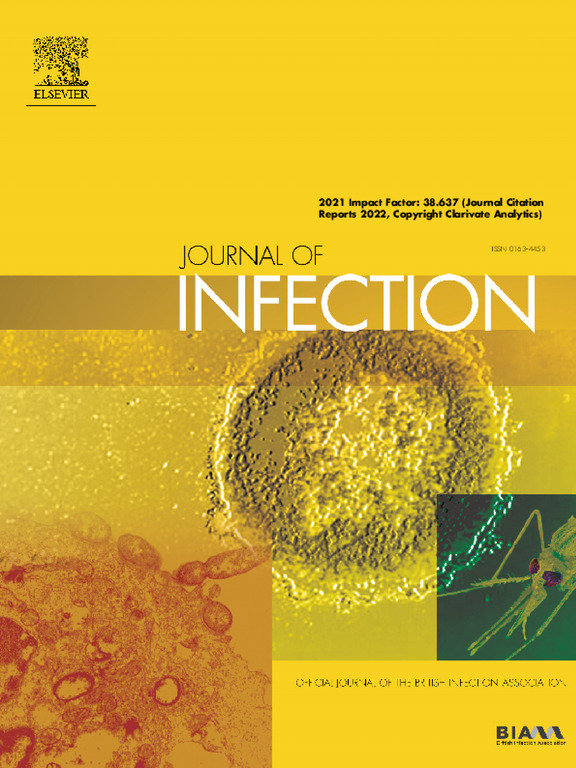基于单细胞RNA-seq分析聚类结核分枝杆菌特异性CD154+CD4+ T细胞以区分结核病和感染
IF 14.3
1区 医学
Q1 INFECTIOUS DISEASES
引用次数: 0
摘要
背景区分活动性结核病(TBD)和潜伏性结核感染(TBI)对结核病控制至关重要,但仍然具有挑战性。方法对纯化的结核分枝杆菌(MTB)特异性CD154+CD4+ T细胞进行单细胞RNA测序。结果我们观察到CD154在检测MTB感染中的优越作用,然而由于患者异质性,其区分TBD和TBI的能力仍然有限。mtb特异性CD154+CD4+ T细胞的单细胞RNA测序鉴定出10个不同的簇,包括Treg, T_act, Th1_pex, Th1_eff, Tfh, T_na, Th17_ex, Th2, NKT和Th1_cyt。值得注意的是,TBD的CD154+CD4+ T细胞中以效应细胞和凋亡细胞为主。然而,Tfh细胞是TBI的主要组成部分。大多数Th1_pex细胞位于发育轨迹的末端,受与凋亡和早期衰竭相关的关键基因调控,如GADD45B、FOS和EZH2。氧化应激诱导的代谢紊乱,以氮、半胱氨酸和谷胱甘肽代谢增加为特征,也有助于Th1_pex细胞的凋亡。利用CD154+CD4+ T细胞NA、CM、EM、EMRA、CXCR3+ Th1、IFN-γ+ Th1、Tfh等7个特征将TBD和TBI分类为不同亚型,进一步建立随机森林模型可准确区分TBD和TBI。此外,耗尽mtb特异性Th1细胞的关键检查点被确定,阻断ADORA2A有效地恢复其功能。结论揭示了TBI到TBD过程中mtb特异性CD154+CD4+ T细胞的细胞组成、转录特征和发育轨迹,为疾病的诊断和预后提供了新的方向。本文章由计算机程序翻译,如有差异,请以英文原文为准。

Clustering Mycobacterium tuberculosis-specific CD154+CD4+ T cells for distinguishing tuberculosis disease from infection based on single-cell RNA-seq analysis
Background
Distinguishing between active tuberculosis disease (TBD) and latent tuberculosis infection (TBI) is crucial for TB control but remains challenging.
Methods
Single-cell RNA sequencing was conducted on purified Mycobacterium tuberculosis (MTB)-specific CD154+CD4+ T cells.
Results
We observe a superior role of CD154 in detecting MTB infection, whereas its ability in distinguishing TBD from TBI is still limited due to patient heterogeneity. Single-cell RNA sequencing of MTB-specific CD154+CD4+ T cells identifies 10 distinct clusters, including Treg, T_act, Th1_pex, Th1_eff, Tfh, T_na, Th17_ex, Th2, NKT, and Th1_cyt. Notably, effector and apoptotic Th1 cells are predominant in CD154+CD4+ T cells of TBD. However, Tfh cells are the primary component in TBI. Most Th1_pex cells are positioned at the end of the developmental trajectory and are regulated by key genes associated with apoptosis and early exhaustion, such as GADD45B, FOS, and EZH2. Oxidative stress-induced metabolic disorder, marked by increased metabolism of nitrogen, cysteine, and glutathione, also contributes to the apoptosis of Th1_pex cells. Using seven features including NA, CM, EM, EMRA, CXCR3+ Th1, IFN-γ+ Th1, and Tfh of CD154+CD4+ T cells, both TBD and TBI can be classified into different subtypes, and a further established random forest model can accurately differentiate TBD from TBI. Additionally, the key checkpoints of exhausted MTB-specific Th1 cells are identified and blocking ADORA2A efficiently restores their function.
Conclusions
We depict the cellular compositions, transcriptional characteristics, and developmental trajectories of MTB-specific CD154+CD4+ T cells from TBI to TBD, putting forward a new direction in the diagnosis and prognosis of disease.
求助全文
通过发布文献求助,成功后即可免费获取论文全文。
去求助
来源期刊

Journal of Infection
医学-传染病学
CiteScore
45.90
自引率
3.20%
发文量
475
审稿时长
16 days
期刊介绍:
The Journal of Infection publishes original papers on all aspects of infection - clinical, microbiological and epidemiological. The Journal seeks to bring together knowledge from all specialties involved in infection research and clinical practice, and present the best work in the ever-changing field of infection.
Each issue brings you Editorials that describe current or controversial topics of interest, high quality Reviews to keep you in touch with the latest developments in specific fields of interest, an Epidemiology section reporting studies in the hospital and the general community, and a lively correspondence section.
 求助内容:
求助内容: 应助结果提醒方式:
应助结果提醒方式:


